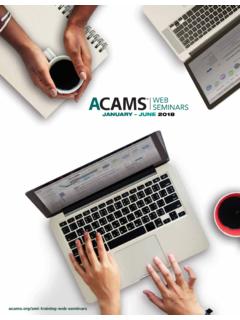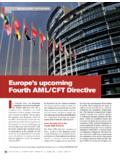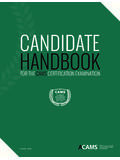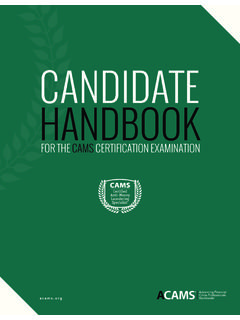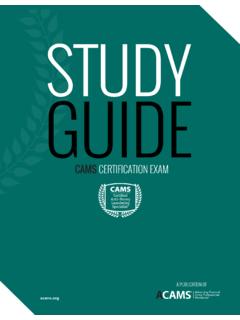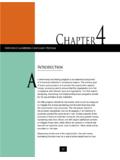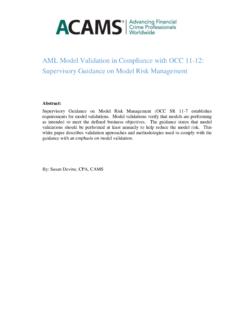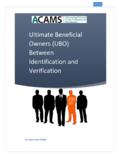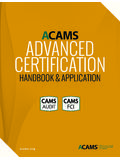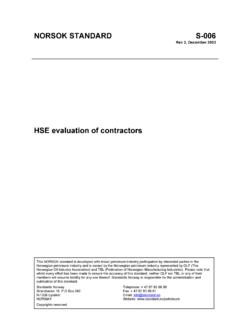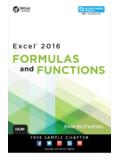Transcription of Combating the Layering and Integration of Money …
1 Combating the Layering and Integration of M o n e y Laundering by Debit Card Sun, Qian CAMS-Audit Advanced Certification White Paper Table of Content 1 BACKGROUND INTRODUCTION .. 3. 2 DEFINITION AND FEATURE OF DEBIT CARD .. 3. Card Classification .. 3. Stakeholders and Roles .. 3. Features of Debit Card .. 4. 3 TRANSACTION TYPE AND SCENARIO .. 5. Transaction Types .. 5. Transaction 6. 4 TYPICAL Money LAUNDERING TECHNIQUE .. 6. Placement .. 6. Layering .. 7. Integration .. 7. 5 DIFFICULTY IN DEBIT CARD AML .. 8. Overseas Debit Card .. 8. Cooperation and Information Sharing .. 8. Accountability Awareness.
2 9. Bucket 9. 6 APPROACHTO MITIGATE Money LAUNDERING 9. Establishing Universal standards and Upgrading .. 9. Cooperation in Investigation and Information Sharing .. 11. Implementation, Regulation and Law Enforcement .. 12. 7 TESTING PROCEDURE .. 12. Set Expectation and Recognize Environment .. 12. Evaluate Technical Compliance .. 14. Assess Implementation Effectiveness .. 14. Define Residual Risk and Propose Improvement Suggestion .. 15. 8 CONCLUSION .. 15. 9 REFERENCE .. 16. 2. 1 BACKGROUND INTRODUCTION. Debit cards are a basic and popular financial instrument all over the world, and they have inevitably been used throughout all three stages of Money laundering.
3 In recent years, along with new technologies adopted in the financial system, debit card payments have become a very convenient and efficient option, particularly in Asia-Pacific countries and regions where debit cards are widely used in not only cash withdrawal but also purchase transactions. In addition to many researches that have been introduced to address and mitigate Money laundering risks related to debit cards, this article will focus on the Layering and Integration stages. This article will first analyze the vulnerability of debit cards in Money laundering, explain how debit cards could be used to facilitate Money laundering (particularly in the Layering and Integration stages), and encourage a holistic solution through the joint efforts of all stakeholders.
4 In addition, this article will propose a solution for testing and auditing procedures. The expected audience of this article should be debit card stakeholders, including card issuers, card acquirers, cardholders, merchants, regulators, and other financial or non-financial institutions whose services are based on debit cards. 2 DEFINITION AND FEATURE OF DEBIT CARD. Card Classification "A bank card is typically a plastic card issued by a bank to its clients that performs one or more of a number of services that relate to giving the client access to funds, either from the client's own bank account, or through a credit account.
5 "1. In fact, there are multiple dimensions to classify a bank card; for example, it can be classified as a: Debit or credit card based on the difference in source of funding Plastic or digital cards based on whether it has a physical presence Chip or magnetic cards based on whether the carrier of data and information is a microchip or a magnetic strip, and so on. Debit cards are typically issued by a bank when the cardholder registers for a savings or checking account. Unlike credit cards, the funds disbursed from a debit card are from the account balance that the cardholder deposited previously rather than a line of credit offered by the bank.
6 Stakeholders and Roles 1 3. From an AML perspective, there are generally five roles involved in the debit card world: issuer, acquirer, cardholder, merchant, card scheme or switching center and regulator. An issuer can be a bank, a non-bank financial institution, or even a non- financial entity. For example, a gym or a barbershop may issue a card to a client. As for a debit card, the issuer will have to be a bank because it has to be issued based on a savings account and in most cases only banks can absorb savings from a crowd. An acquirer is an entity that accepts the usage of the debit card.
7 For example, when a debit card is used to withdraw cash from an ATM, the owner of the ATM is the acquirer. A cardholder, as its literal meaning, is the holder of a debit card and would normally should be the owner of the savings account tied to the debit card. A merchant is a relative concept to a cardholder. For example, when a debit card is used for a POS transaction to purchase goods or services, the seller or provider is the merchant. A card scheme or switching center is based on a standard interchange technical standard and it facilitates the usage of debit cards among different issuers, merchants and acquirer located in different countries.
8 A regulator is the same as its role in any industry, which supervises and regulates debit card activities. Features of Debit Card Portability. If we only consider physical cards, a debit card is a papery piece of plastic (sometimes metal) no larger than 6cm x 10cm, which makes debit cards very portable. Cardholders can keep a dozen debit cards within a small purse in hand without been inquired by any customs inspector. There are cases of smuggling cash, goods, drugs, etc., but not debit cards. High Value. Because debit cards are linked to saving accounts, the available value of a debit card is equal to the outstanding balance of the savings account, and such balance is reloadable.
9 Wide scope of acceptability. The acceptance network of debit cards is now covered almost everywhere. For example, according to the descriptions provided on official websites of top three international card schemes, VISA says it "connect[s] consumers, businesses, banks and governments in more than 200 countries and territories worldwide."2 UnionPay says it "has enabled card acceptance in 160 countries and regions,"3 and MasterCard says it connects ". 2 3 4. consumers, financial institutions, merchants, governments and businesses in more than 210 countries and territories."4. Support of various use pattern.
10 Debit cards can be used to deposit or withdraw cash, to fund a payment transaction, to send or receive, to transfer, etc. They are accepted by terminals like POS and ATMs, and by intangible interfaces like internet website and mobile phone applications. Debit cards have become the primary vehicle for conducting transactions in countries where paper checks have not been a form of payment traditionally. According to a report published in China, in 2015 there was a total of billion bank cards issued billion of these were debit cards, which means approximately each Chinese citizen owns four debit cards.
